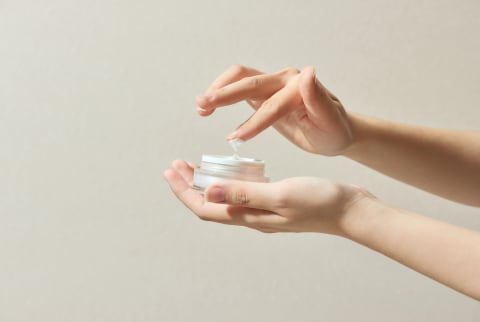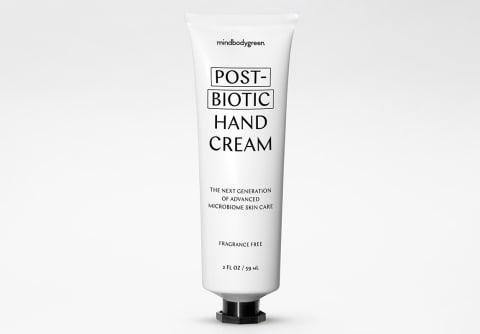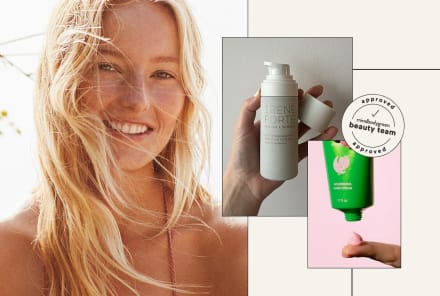Advertisement
Barrier Cream: Benefits, Usage Tips & Our Favorite Products


It feels that every so often in the beauty space we are introduced to a new category of products we simply must purchase: lip masks, acne patches, gommage peels, and various other tonics. Now, we're all for finding products that bring you joy—no matter what category they happen to fall into. After all, skin care is a personal thing that should feel particular and important to you, and who's to say what that looks like exactly?
Now, hearing the term "barrier cream" may inspire you to go to your nearest web browser and type the phrase into your favorite beauty retailer, looking for the next big thing. But barrier creams are truly nothing new in the skin care space. They go by many monikers: ointments, salves, creams, and even more recently, night masks. These all have the same directive: Create a topical barrier to your skin.
Here's what you need to know.
What is a barrier cream?
The definition is pretty simple: any cream that creates a physical, topical barrier on skin. Often those with dry, sensitive, and irritation-prone skin will default to a barrier cream—especially in the evening. (Some people find them to be too thick for daytime use or under makeup.) The creams tend to be made with emollients and occlusive ingredients, like butters, waxes, and oils. They can also include other active ingredients to support your barrier, such as physical UV protectants, antioxidants, and biome-friendly ingredients.
Benefits of a barrier cream:
Here's what you can expect from adding a barrier cream to your routine—or what you might already be experiencing if one is already in the lineup:
Hydration and stops transepidermal water loss.
Barrier creams keep skin moisturized by infusing the epidermis with emollients and water while also trapping it all in with the occlusive film. "Occlusives form a protective seal over the skin to lock in hydration and the products applied under them," says board-certified dermatologist Joshua Zeichner, M.D.
See, when your skin barrier is weakened or compromised—as is often the case with those who have sensitive or dry skin—something called transepidermal water loss happens. This is when water in your skin evaporates into the air around you, leaving your epidermis thirsty.
Healthy, robust skin is able to prevent this from happening mostly on its own. However, some skin types (again, sensitive and dry skin) usually need a bit of help; thus, those with these skin types are often encouraged to use thick creams to seal in moisture.
Protect the microbiome and moisture barrier.
Your skin microbiome is the collection of bacteria, fungi, and flora that lives on your skin. It's a delicate thing that may be influenced by external influences. Those with dry, damaged skin usually have some imbalances in the skin microbiome. And to get your barrier back to optimal health, it's critical that you tend to the biome.
"The microbiome also aids in wound healing, limits exposure to allergens, minimizes oxidative damage, and keeps the skin plump and moist," according physician Kara Fitzgerald, N.D.
So barrier creams with biome-friendly ingredients—such as pre-, pro-, and postbiotics—can help your microbiome flourish, helping your skin stay hydrated and protected.
Protection from external aggressors.
Thick salves add a layer of protection from the elements, protecting you from pollution, various other particulate matter, even the elements like cold weather and windburn. "When low humidity and low temperature damage the skin barrier, this weakens the skin's ability to protect itself, leading to red, dry, scaly skin," agrees board-certified dermatologist Hadley King, M.D.
As for pollutants, you can also incorporate antioxidants into the cream, so they can tend to free radical damage that comes with external stressors. You can look for creams with added actives—like vitamin E, niacinamide, and vitamin K—or simply find one formulated with natural plant oils that will have antioxidant properties as well, like jojoba and argan oils.
Other ingredients that may fall under this umbrella? Zinc oxide and titanium dioxide, or the two minerals used in natural, physical SPF. "Mineral sunscreen ingredients, like zinc oxide and titanium dioxide, sit on top of the skin to scatter and deflect UV rays, physically blocking them from penetrating the skin," says King.
How to use + cautions.
Barrier creams come with simple, easy-to-follow instructions. No fuss here:
- Always apply this product last in your skin care lineup. As it's supposed to act as a shield, anything you'd hypothetically apply after it won't be able to penetrate the skin. Read: It's OK to apply makeup after (as you don't want that to sink into skin) but not serums or other potent actives (as that should touch freshly clean skin).
- If you find it too thick, consider just using it at night. We know that your skin is more permeable at night—thus loses more water—so slathering on a denser product during your evening routine can help you wake up hydrated and refreshed.
- Be cautious about ingredients if you are acne-prone. Those with acne may still feel the need to opt for a barrier cream, as sometimes acne can be the result of dry, inflamed, sensitive skin. However, thicker creams may contain comedogenic ingredients, which will only further clog pores.
How to find one
As we noted, barrier creams are something of a distinction without a difference, so there's no regulated definition or standards of the term. Finding one really comes down to finding a rich cream with barrier protecting qualities. A few good things to look for:
- Lipids, butters, and oils. There are plenty of plant lipids that can help support your moisture barrier. These can blanket the skin in a comforting layer of hydration, and are usually dense enough that they trap the water in the skin too. Look for ingredients like shea butter, mango butter, moringa seed oil, olive oil, squalene (or squalane), and coconut oil.
- Biome ingredients. By definition, biome ingredients are meant to sit on the surface. Pre-, pro-, and postbiotics can help nurture the skin microflora, which will aid in barrier function—as the microbiome is a major player in the barrier overall.
- Soothing emollients and botanicals. Part of the reason your barrier weakens is because of irritation and inflammation. That's why it's vital to use calming ingredients, since they can help temper reactive skin, as well as help seal in cracks caused by inflammation.
If you want further guidance, check out our favorite barrier creams here.
The takeaway.
If you suffer from sensitive or dry skin, you may consider upping your cream game. Barrier creams, or just an umbrella term for those that create a thick, supportive seal on the skin, just might be what you need. They help your microbiome thrive, stop transepidermal water loss, and protect your skin.
Watch Next
Enjoy some of our favorite clips from classes
Enjoy some of our favorite clips from classes
What Is Meditation?
Mindfulness/Spirituality | Light Watkins
Box Breathing
Mindfulness/Spirituality | Gwen Dittmar
What Breathwork Can Address
Mindfulness/Spirituality | Gwen Dittmar
The 8 Limbs of Yoga - What is Asana?
Yoga | Caley Alyssa
Two Standing Postures to Open Up Tight Hips
Yoga | Caley Alyssa
How Plants Can Optimize Athletic Performance
Nutrition | Rich Roll
What to Eat Before a Workout
Nutrition | Rich Roll
How Ayurveda Helps Us Navigate Modern Life
Nutrition | Sahara Rose
Messages About Love & Relationships
Love & Relationships | Esther Perel
Love Languages
Love & Relationships | Esther Perel
-v1646695196476.jpg?1148x800)


















